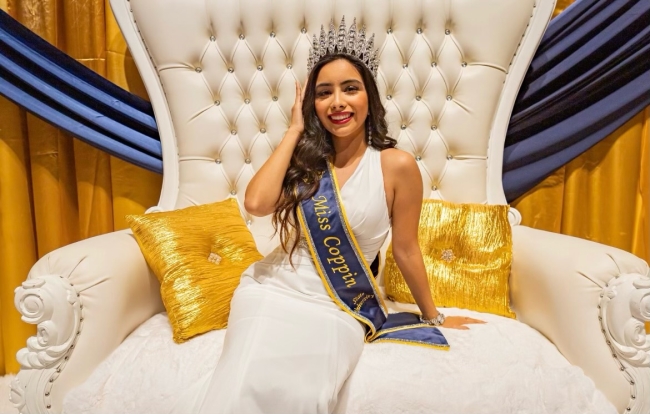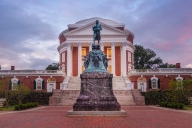You have /5 articles left.
Sign up for a free account or log in.

Keylin Perez attends her coronation ceremony, where she was crowned Miss Coppin State this past fall.
Coppin State University
Keylin Perez, a senior at Coppin State University, was thrilled to be the first Latina crowned Miss Coppin State University, or the university “queen,” a student leadership role at the historically Black institution in Baltimore. She ran unopposed, but not everyone is excited about her win.
Perez recently received a surge of vitriol and harassment on social media after she posted a lighthearted TikTok video of her and Mister Coppin bumping into their counterparts at Morgan State University, another HBCU in Baltimore. Commenters on TikTok, Instagram and Twitter from outside the university berated her for occupying a ceremonial position they believe should be held by a Black student, the Baltimore Banner first reported.
Perez turned off the comment thread on the video, but the negative remarks kept rolling in on multiple online platforms. She said she also faced some backlash on social media when she was first elected last spring, but it was nothing like the current blowup over the appropriateness of her holding the title.
“It was getting very overwhelming,” she said. Strangers direct messaged her with “long paragraphs that I shouldn’t be in this position, I should harm myself and so on.”
Perez, the daughter of Guatemalan immigrants, explained on Instagram why she chose to attend an HBCU and run for the position after serving in two other leadership roles, Miss Sophomore and Miss Junior. She described feeling uncomfortable in high school as one of only four Hispanic students with a small group of Black classmates and how at home she felt in the “family oriented environment” at Coppin State.
“I was bullied in middle school and part of high school for being Latina,” wrote Perez, a nursing and military science major and a sergeant in the Army Reserves. “I never felt accepted, and when I stepped foot on the campus of THEE Illustrious Coppin State University, I felt peace and love.”
She said she received a warm welcome from Coppin’s king and queen at the time and found an immediate sense of community on the cheerleading team. She wanted to serve the campus that gave her so much care and support.
Perez’s Instagram post garnered over a thousand comments, including some continuing to question her legitimacy as Miss Coppin State.
“Why can’t Black people just have things that exclusively belong to us?” one commenter replied to the post. Another commenter wrote “stop invading our space gtfo,” shorthand for “get the fuck out.”
Perez has also experienced a groundswell of support from peers and administrators at Coppin State in response to the social media storm. The president of the university, Anthony L. Jenkins, made a public statement defending her, and fellow students have left supportive comments on her social media accounts. The student body at Coppin State is currently about 80 percent Black, about 3 percent Hispanic and 1.2 percent white.
Hispanic students are increasingly attending HBCUs, said Deborah Santiago, co-founder and CEO of Excelencia in Education, an organization focused on Latino student success. Data from Excelencia show that Hispanic students made up 7 percent of HBCU enrollments during the 2020–21 academic year. HBCUs enroll 18,402 Latino students, or 1 percent of all Latino undergraduates in the U.S.
Santiago noted that sometimes these institutions are just located in areas where Hispanic communities are growing, but many Hispanic students also feel “an affinity to institutions committed to serving students of color.” She said Black student enrollments are also growing at Hispanic-serving institutions, and she believes it’s for the same reason.
Jenkins said HBCUs can still be rooted in Black history and culture even as they diversify and embrace non-Black students as full members of their campuses.
“We fight against all types of discrimination,” he said. “We are about inclusiveness on our campus. We’d rather not waste our intellectual strength on trying to convince people of their shortcomings and ignorance. We will continue to circle the wagons around Keylin, and she will have a wonderful reign as Miss Coppin State University. And for all of the naysayers and the cynical people, we’ll let them go build their own campfire and tell their own stories, but we’re not going to entertain that nonsense.”
“Keylin is a special woman,” he added. “This is bigger than her.”
Old Traditions, New Demographics
Crowning a royal court—selecting a “miss” and “mister” or “king” and “queen,” among other student roles—is a time-honored HBCU tradition dating back to the 1920s. The practice grew in popularity in the 1970s, when Ebony magazine started featuring pictures of the winners at HBCUs across the country, said Dale Williams, founder of the HBCU Kings and Queens Conference, an annual gathering and training program for these student leaders. The king and queen at Coppin State, who participate in a pageant followed by a student vote, are intended to serve as yearlong role models to the student body and representatives of the institution. They also attend events in their formal capacity and run student activities.
Williams said the role of queen is akin to a “campus celebrity,” and the position can come with harsh criticism. She commended Perez for holding her own amid the pushback. Coppin State isn’t the first HBCU to elect a non-black queen; Kentucky State University and Talladega College faced similar backlash after selecting white queens in the past, she said. (Note:This sentence was revised to indicate that Coppin State was not the first HBCU to elect a "non-black queen." )
“I don’t agree with reverse racism, and that’s what it is,” Willams said. If a Black student won a pageant or a leadership role at a predominantly white university, “are you saying they don’t deserve to be there?”
The backlash experienced by Perez ties into larger and sometimes fraught discussions happening among HBCU students and alumni about the legacy and culture of HBCUs as these institutions attract more non-Black students. Non-Black students made up a full quarter of HBCU enrollments in 2021, compared to 15 percent in 1976, according to the National Center for Education Statistics.
Some welcome the influx of non-Black students as a sign of HBCUs’ prestige and prominence and appreciate the added diversity and enrollment boost. Others are jarred by the shift and question if HBCUs can preserve their focus on Black students while welcoming or actively recruiting non-Black students.
For example, Lincoln University faced criticism from alumni after its president suggested recruiting students locally in a predominantly white region. The Missouri HBCU had a student body that was about 40 percent white at the time. Morehouse College also raised eyebrows in 2008 when its valedictorian was a white student.
HBCUs “are known to be places where Black students go to get in contact with their culture, to find out more about their identity and to see students and faculty who look like them and, to some extent, have the same experiences,” said Robert Palmer, professor and chair of educational leadership and policy studies at Howard University. It can “cause a cognitive dissonance” when a student comes to an HBCU, excited to participate in traditions like royal courts, and finds the student leaders representing them aren’t Black.
But he doesn’t think recruiting non-Black students alters the identity or mission of HBCUs. These institutions can be safe havens for Black students and also guide students in “conversations that are going to play out in a larger societal context about differences” and prepare them “to meet people from different walks of life.”
But HBCUs could do a better job of talking with students about campus diversity as their demographics change, he said. And he believes those conversations should include not only racial and ethnic diversity but diversity among Black students themselves in terms of gender, sexual orientation and other differences that can affect the student experience. He also wants to see HBCU leaders fielding campus climate surveys and publicizing the results to have a better understanding of their students’ diverse needs and any potential tensions.
Santiago, of Excelencia in Education, said all colleges and universities with changing demographics, not just HBCUs, are wrestling with questions about who represents an institution and who should feel a sense of belonging there.
“We’ve seen a perpetual challenge to figure out who belongs, who decides and what’s the role of an institution or broader society in determining that,” she said. “It’s continual. If you’re an HSI with a mission to serve Hispanic students, does that mean you’re not serving white students? If you were created with a mission to serve Black students during a time of ... segregation, does that mean you cannot serve white students?”
Those discussions can be tense but also offer a “richness and opportunity” to “think about race and ethnicity and how students feel like they belong and fit in,” she added.
Jenkins said he celebrates that students of all types are attracted to Coppin State. He added that non-Black people helped to run and teach at HBCUs since their founding.
“We are historically Black, but we’re not exclusively Black,” he said. “Diversity has been a part of our existence since day one.”
Perez, meanwhile, will continue in her position. She said she hasn’t let criticism make her feel like she doesn’t belong.
“I just have to reflect on why I’m here,” she said. “At the end of the day, I’m here for a reason. The student body wanted me … I just had to remain focused and grounded on that.” Stepping down was “never an option for me.”





